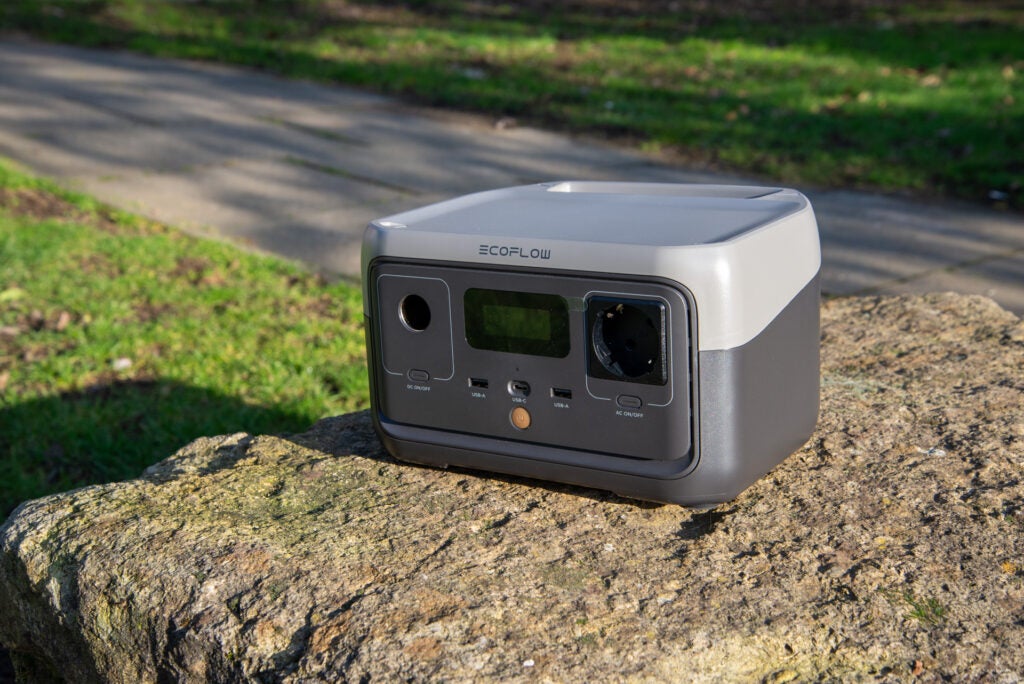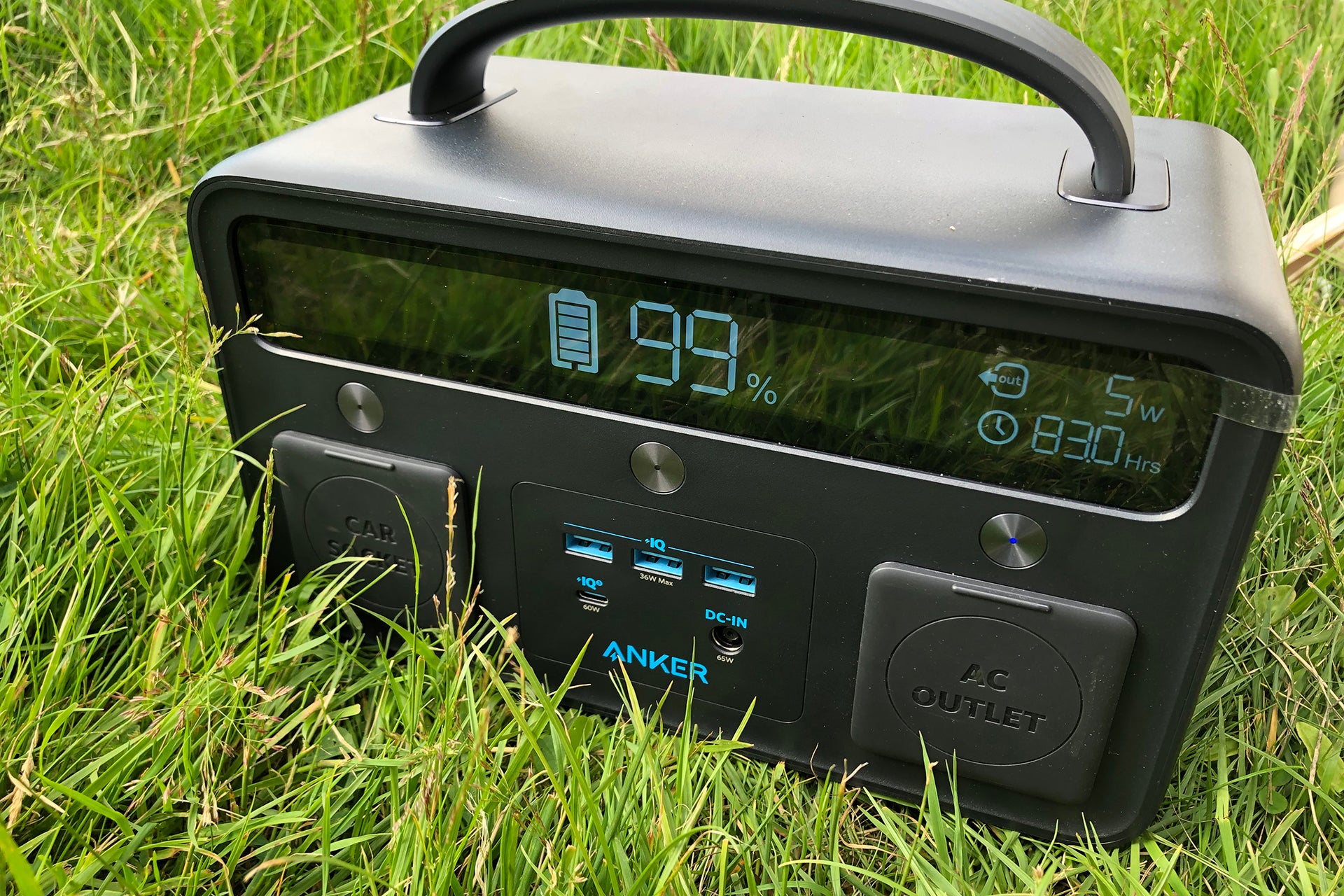Verdict
At this price, the Ecoflow River 2 has tough competition, but there are enough differences here to make this a power station worth buying for some: it charges in an hour, and it can support AC devices up to 600W. If you need this combination, this is a great power station for short trips.
Pros
- High power output
- Fast charging
- Small
Introduction
Having power on the move is useful, but not everyone needs kilowatts of power when they’re away. For those people, there’s the Ecoflow River 2, a smaller power station with 256Wh of power.
It’s best used for DC devices, such as for charging phones and tablets, but there is a power socket that can output 600W for regular devices.
Design and features
- Two USB ports
- Single AC outlet
- Handy carry handle
At just 3.5kg, the advantage of the Ecoflow River 2 is that it’s easy to carry around, particularly as there’s a handy handle at the back. This is the kind of power station you can lug around easily enough on a week’s camping or stash in a car to provide power for tablets and phones.
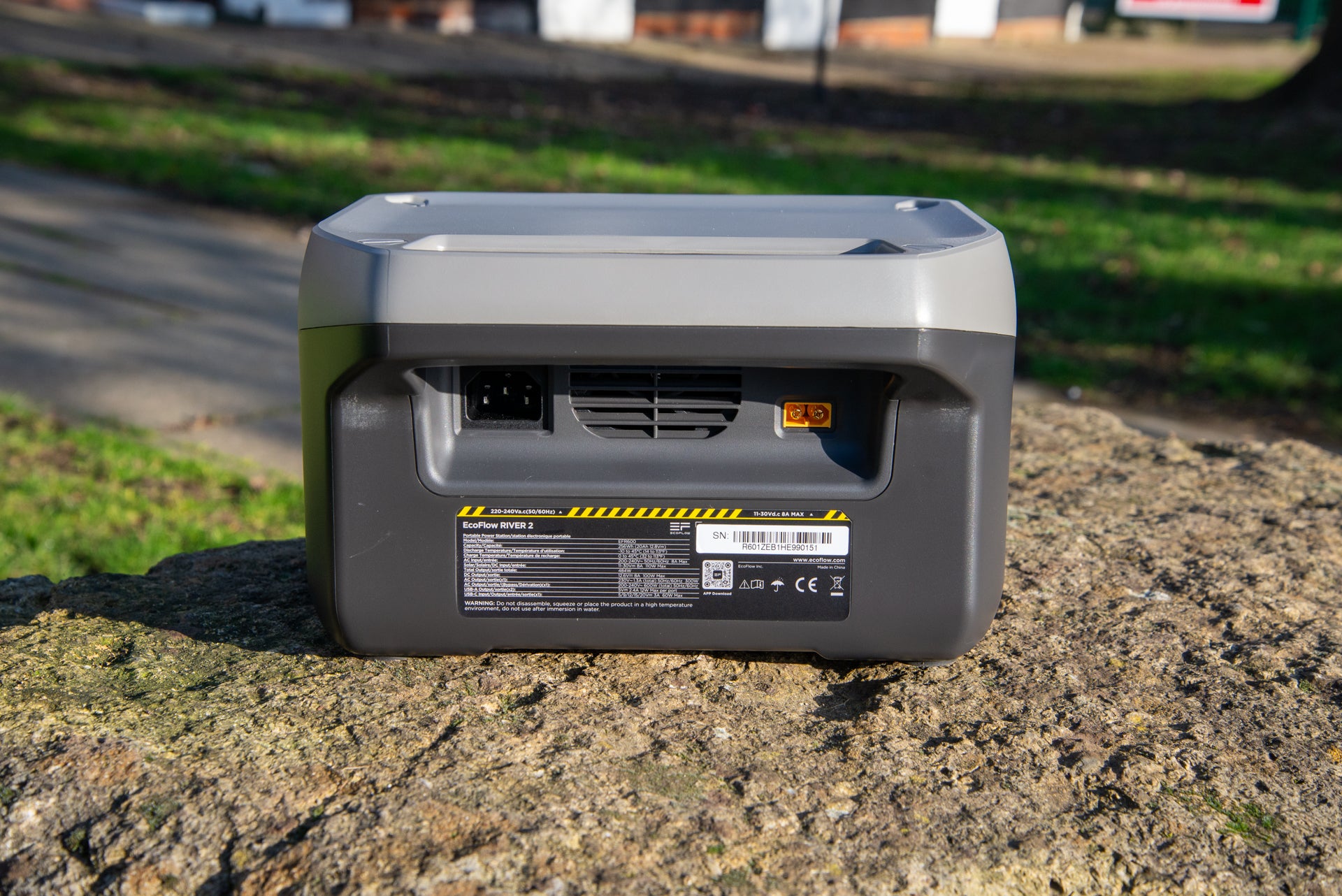
This makes the Ecoflow River 2 quite similar in size and weight to the Anker PowerHouse 521, although the latter is a little larger as it squeezes in a torch.
As you might expect, there’s a limited but useful range of ports for such a small product. There are two USB-A (12W max) and one USB-C port (60W, so good enough to power a laptop).
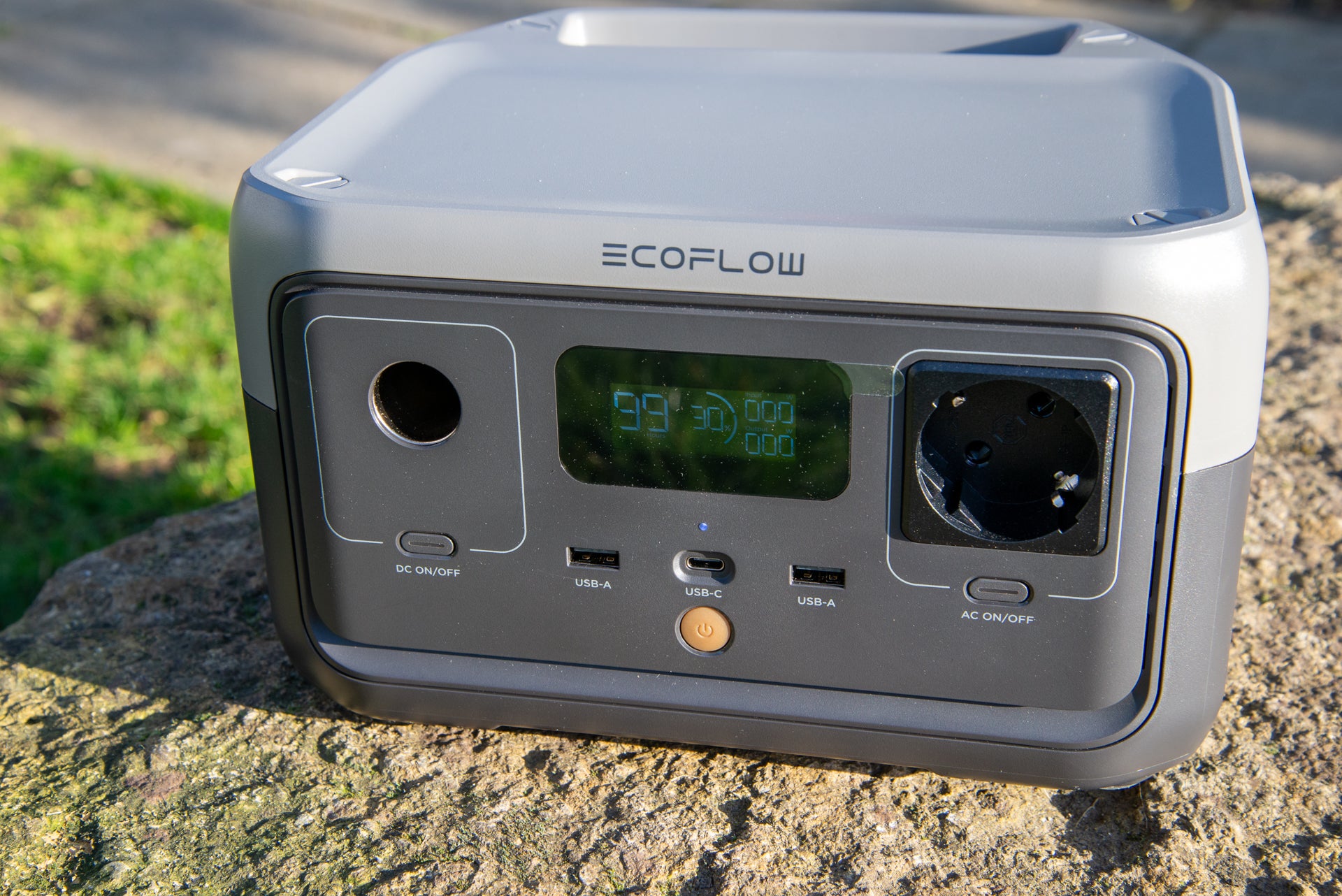
Rounding off the DC outputs is a 12V car output, rated at 100W, so you can use it to power typical car accessories such as portable coolers.
There’s a single AC outlet. I was sent the European version of the product, but there is a version with a standard UK plug. In either case, the output spec is the same: a maximum output of 300W, supporting a surge of 600W with X-Boost, which can be turned on via the EcoFlow app.
That’s good enough for smaller devices, such as portable pumps, laptop chargers and fans, but you’ll struggle to power more intensive devices, such as coffee machines. That’s not an issue, given that there’s only a 256Wh battery, which would be drained quickly.
The power station turns the USB ports on and off, while the 12V car and AC outlet have their own button. It’s worth turning the AC outlet off when not used, as the inverter will draw power otherwise.
As with other EcoFlow battery stations, such as the Delta 2, there’s a useful LCD screen on the front. This shows the current charge status as a percentage, the power draw and input level in Watts, and a time to charge/time to discharge counter in minutes.
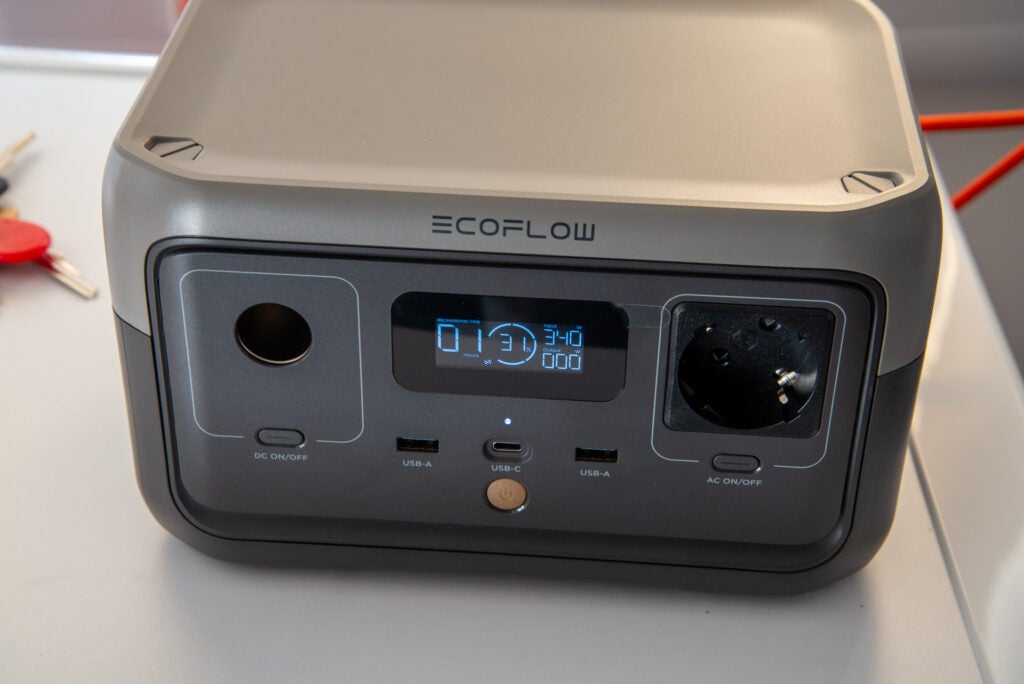
Charging and solar
- 110W solar input
- 360W mains charging
Charged via the kettle plug in the box, the Ecoflow River 2 can take a 360W input, which can recharge the battery in just an hour. That’s handy for quick turnarounds. That’s also a lot faster than the Anker PowerHouse 521, which takes four hours to charge using its power adaptor, and 2.5 hours if the USB-C input is used, too.
I charged the Ecoflow River 2 from empty and found that it used 0.322kWh of power, making charging 79.5% efficient. That’s a chunk less efficient than the PowerHouse 521, although I would take lower efficiency and faster charging speeds any day.
With its solar input, I used EcoFlow’s 110W solar panel (£249). As with all the company’s products, these panels are stored inside a handy carry case, which can be folded to act as a stand. It’s fairly fiddly to clip the carabiners in place, and I prefer the design of Anker’s solar panels, which have stands built in.
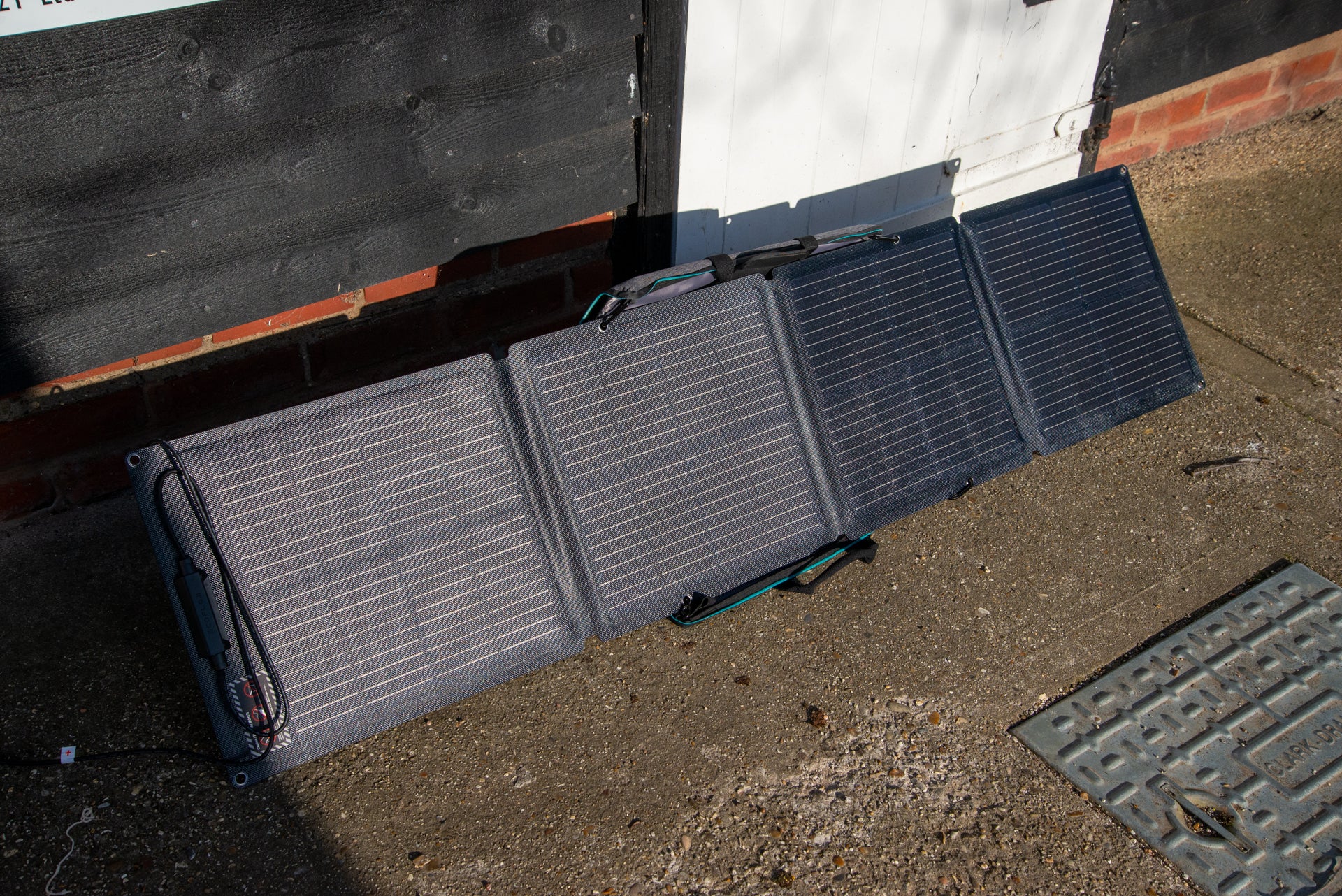
With this solar panel, it can take around four hours to recharge the battery station, assuming good sunlight. Still, if you’re going camping in the sunnier months and want to keep the power topped up, solar is a good shout.
Performance
- Very quiet
- Good efficiency
- Long battery life
I tested the Ecoflow River 2 with an air purifier, drawing 50W from the AC outlets. Draining the battery fully, I measured the power output at 164Wh. That’s a 64% efficiency, which is similar to the performance of the PowerHouse 521.
That’s not terrible, given that the inverter that converts DC power from the battery to AC power for the outlet draws considerable power. Upping the load would increase efficiency, but drain the battery faster.
Ultimately, if you want to use a lot of AC devices, then you’re going to be better off with a larger power station, such as the Dabbsson XXXX. Using the DC output (USB and car) is far more efficient, as there’s no need for the inverter.
With X-Boost turned on, I could push the power output, even using a low-power heater. Of course, the issue with that is that the 256Wh battery drains very fast. Really, this is a device aimed at lower-power devices.
When plugged into the mains, the Ecoflow River 2 can act as an EPS. Power is passed through the battery to connected devices, with a 30ms switchover before the battery takes over. That’s good enough for a lot of equipment, but not as fast as a UPS for a computer.
Using a LiFeP04 battery, the Ecoflow River 2 can handle 3000 charge cycles until the battery is at 80% capacity. That’s around 768kWh of power in total. Adjusted for the Ecoflow River 2’s price that’s around 35p per kWh stored. Not bad for the size of device and only larger, more efficient power stations significantly bring the price down.
Of course, the Ecoflow River 2 will contiue working after this point, although capacity will continue to diminish. Even so, expect the Ecoflow River 2 to last for 10 years or so.
There is a fan in this unit, although it rarely turned on, so I found the Ecoflow River 2 very quiet.
Latest deals
Should you buy it?
You want fast charge times and high power output: This power station charges in an hour and can take devices up to 600W.
You want a torch or something cheaper: There are similar-capacity devices for less, and a power station with a torch can be useful for camping.
Final Thoughts
The main competition is the Anker PowerHouse 521, which is slightly cheaper at the same capacity. The PowerHouse 521’s advantages are that it is slightly more efficient, it has a torch, and the overall design is a little neater and more rugged. On the flip side, the Ecoflow River 2 is faster to charge, a touch smaller and has a higher AC power output, which could make it the better choice for some.
How we test
We test every battery station we review thoroughly over an extended period of time. We use standard tests to compare features properly. We’ll always tell you what we find. We never, ever, accept money to review a product.
Find out more about how we test in our ethics policy.
FAQs
This battery station can handle devices up to 600W.
Verdict
At this price, the Ecoflow River 2 has tough competition, but there are enough differences here to make this a power station worth buying for some: it charges in an hour, and it can support AC devices up to 600W. If you need this combination, this is a great power station for short trips.
Pros
- High power output
- Fast charging
- Small
Introduction
Having power on the move is useful, but not everyone needs kilowatts of power when they’re away. For those people, there’s the Ecoflow River 2, a smaller power station with 256Wh of power.
It’s best used for DC devices, such as for charging phones and tablets, but there is a power socket that can output 600W for regular devices.
Design and features
- Two USB ports
- Single AC outlet
- Handy carry handle
At just 3.5kg, the advantage of the Ecoflow River 2 is that it’s easy to carry around, particularly as there’s a handy handle at the back. This is the kind of power station you can lug around easily enough on a week’s camping or stash in a car to provide power for tablets and phones.

This makes the Ecoflow River 2 quite similar in size and weight to the Anker PowerHouse 521, although the latter is a little larger as it squeezes in a torch.
As you might expect, there’s a limited but useful range of ports for such a small product. There are two USB-A (12W max) and one USB-C port (60W, so good enough to power a laptop).

Rounding off the DC outputs is a 12V car output, rated at 100W, so you can use it to power typical car accessories such as portable coolers.
There’s a single AC outlet. I was sent the European version of the product, but there is a version with a standard UK plug. In either case, the output spec is the same: a maximum output of 300W, supporting a surge of 600W with X-Boost, which can be turned on via the EcoFlow app.
That’s good enough for smaller devices, such as portable pumps, laptop chargers and fans, but you’ll struggle to power more intensive devices, such as coffee machines. That’s not an issue, given that there’s only a 256Wh battery, which would be drained quickly.
The power station turns the USB ports on and off, while the 12V car and AC outlet have their own button. It’s worth turning the AC outlet off when not used, as the inverter will draw power otherwise.
As with other EcoFlow battery stations, such as the Delta 2, there’s a useful LCD screen on the front. This shows the current charge status as a percentage, the power draw and input level in Watts, and a time to charge/time to discharge counter in minutes.

Charging and solar
- 110W solar input
- 360W mains charging
Charged via the kettle plug in the box, the Ecoflow River 2 can take a 360W input, which can recharge the battery in just an hour. That’s handy for quick turnarounds. That’s also a lot faster than the Anker PowerHouse 521, which takes four hours to charge using its power adaptor, and 2.5 hours if the USB-C input is used, too.
I charged the Ecoflow River 2 from empty and found that it used 0.322kWh of power, making charging 79.5% efficient. That’s a chunk less efficient than the PowerHouse 521, although I would take lower efficiency and faster charging speeds any day.
With its solar input, I used EcoFlow’s 110W solar panel (£249). As with all the company’s products, these panels are stored inside a handy carry case, which can be folded to act as a stand. It’s fairly fiddly to clip the carabiners in place, and I prefer the design of Anker’s solar panels, which have stands built in.

With this solar panel, it can take around four hours to recharge the battery station, assuming good sunlight. Still, if you’re going camping in the sunnier months and want to keep the power topped up, solar is a good shout.
Performance
- Very quiet
- Good efficiency
- Long battery life
I tested the Ecoflow River 2 with an air purifier, drawing 50W from the AC outlets. Draining the battery fully, I measured the power output at 164Wh. That’s a 64% efficiency, which is similar to the performance of the PowerHouse 521.
That’s not terrible, given that the inverter that converts DC power from the battery to AC power for the outlet draws considerable power. Upping the load would increase efficiency, but drain the battery faster.
Ultimately, if you want to use a lot of AC devices, then you’re going to be better off with a larger power station, such as the Dabbsson XXXX. Using the DC output (USB and car) is far more efficient, as there’s no need for the inverter.
With X-Boost turned on, I could push the power output, even using a low-power heater. Of course, the issue with that is that the 256Wh battery drains very fast. Really, this is a device aimed at lower-power devices.
When plugged into the mains, the Ecoflow River 2 can act as an EPS. Power is passed through the battery to connected devices, with a 30ms switchover before the battery takes over. That’s good enough for a lot of equipment, but not as fast as a UPS for a computer.
Using a LiFeP04 battery, the Ecoflow River 2 can handle 3000 charge cycles until the battery is at 80% capacity. That’s around 768kWh of power in total. Adjusted for the Ecoflow River 2’s price that’s around 35p per kWh stored. Not bad for the size of device and only larger, more efficient power stations significantly bring the price down.
Of course, the Ecoflow River 2 will contiue working after this point, although capacity will continue to diminish. Even so, expect the Ecoflow River 2 to last for 10 years or so.
There is a fan in this unit, although it rarely turned on, so I found the Ecoflow River 2 very quiet.
Latest deals
Should you buy it?
You want fast charge times and high power output: This power station charges in an hour and can take devices up to 600W.
You want a torch or something cheaper: There are similar-capacity devices for less, and a power station with a torch can be useful for camping.
Final Thoughts
The main competition is the Anker PowerHouse 521, which is slightly cheaper at the same capacity. The PowerHouse 521’s advantages are that it is slightly more efficient, it has a torch, and the overall design is a little neater and more rugged. On the flip side, the Ecoflow River 2 is faster to charge, a touch smaller and has a higher AC power output, which could make it the better choice for some.
How we test
We test every battery station we review thoroughly over an extended period of time. We use standard tests to compare features properly. We’ll always tell you what we find. We never, ever, accept money to review a product.
Find out more about how we test in our ethics policy.
FAQs
This battery station can handle devices up to 600W.



















